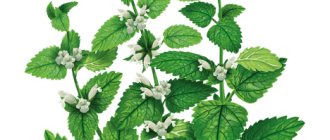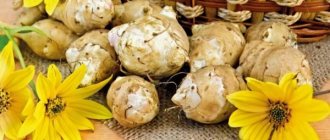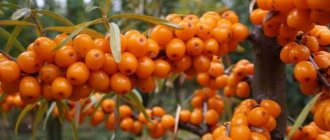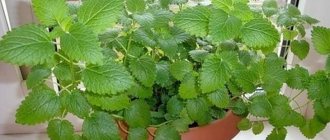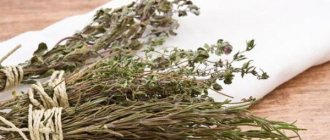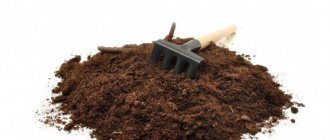Melissa and mint are two certainly very useful plants that are familiar to every person. If you care about your health, you should improve your theoretical base! Let's talk about the difference between the two herbs - let's go through the main characteristics and highlight the significant differences. Don't forget to bookmark our review so you always have it at hand!
Appearance
The first thing that will help you understand the difference between lemon balm and mint is appearance! Let's look at the two plants and get an idea of the differences?
| Characteristic | Mint | Melissa |
| Stem | Straight | Branching |
| Flowers | Purple | Lilac |
| Inflorescence shape | Spikelets | False whorls |
| Stem height | Up to a meter | Up to one and a half meters |
| Leaf shape | Elongated | Ovoid |
Look at the photo of lemon balm and mint so you never confuse them! There is one more little secret - you don’t even have to read the table to figure out the difference between mint and lemon balm:
- Mint leaves are smooth, very bright;
- The second plant has “rough” leaves with a little fluff and is distinguished by a calmer green color.
We looked at photos of what lemon balm and mint look like - it’s time to move on to other, no less important characteristics of herbs!
Chemical composition
100 g of mint contains 70 kcal, but the same amount of lemon balm contains only 49 kcal. True, this information is rather for informational purposes - no more than a few leaves are added to dishes.
Differences in vitamin and mineral composition:
| Useful material | Mint, mg | Melissa, mg |
| Riboflavin | 0,26 | 0,18 |
| Pantothenic acid | 0,34 | 1,78 |
| Ascorbic acid | 31 | 18 |
| Potassium | 569 | 458 |
| Calcium | 243 | 159 |
| Iron | 5,08 | 11 |
The content of vitamin A, folic acid, riboflavin, sodium, manganese is approximately the same amount. But there are also other differences: mint contains copper, much more tannin, tannins, essential oils and bitterness. Therefore, it has antifungal and antiviral effects. Melissa contains fluorine and manganese, its antimicrobial properties are much milder, and when used in traditional medicine recipes it has fewer contraindications.
Taste and smell
First of all, both flowers are valued for their aromatic and taste properties - they are often eaten, teas, infusions, and decoctions are brewed. Let's talk about what is the difference between lemon balm and mint in terms of smell?
The simplest method will help you figure it out - rub the leaf between your fingers to feel the aroma:
- Do you feel notes of lemon, the smell is unobtrusive? Melissa is in front of you;
- If you smell a sharp and spicy aroma of menthol, those are mint leaves.
The differences in smell between lemon balm and mint are obvious; it is impossible to confuse them, even if you don’t understand anything about botany. Approximately the same difference in taste properties can be distinguished:
- Menthol leaves give an appropriately refreshing sharp taste, very tart and slightly bitter;
We also recommend: Seasoning for kharcho
- The second herb gives a citrus flavor - subtle soft notes.
Here it can be noted that it invigorates more - this is undoubtedly an herb containing menthol! Let's move on to the next part of our review?
Melissa during pregnancy. Is it possible to use lemon balm during pregnancy and how to use it correctly?
Lemon mint. This is also the name of the herb, which has a wonderful soft aroma and very useful medicinal properties. Everyone knows lemon balm as a sedative herb. Can it be used by expectant mothers? What do you need to know?
Briefly about Melissa
Melissa looks very similar to mint. But it has a different, lemony smell. Therefore, it is called lemon balm, and also bee balm or lemon grass.
This is a plant from the Lamiaceae family, whose homeland extends from Persia to the Mediterranean. Melissa has been known as a spice and medicinal plant for many millennia. It was grown in Ancient Greece and Rome, and today it is widespread throughout Europe and North America.
Fresh or dried leaves of this plant are added to various dishes to give a special taste; they are used as an additive in teas, liqueurs, for canning, and pickling vegetables. Lemon balm goes well with all types of red meat, fish and mushrooms.
In the pharmaceutical industry, this herb is used to make medicinal teas and other sedatives. Melissa essential oil is popular in perfumery and cosmetology.
Can I have lemon balm during pregnancy?
Melissa and peppermint can be used by women during pregnancy.
The medicinal properties of lemon balm allow it to be used as an anti-inflammatory, antispasmodic, analgesic, hypnotic, and sedative. Lemon balm significantly improves appetite and helps normalize the functioning of the gastrointestinal tract.
As a rule, during pregnancy it is used to treat insomnia. The leaves of this herb have an antiviral effect and help expectant mothers strengthen their immune system due to their high content of vitamin C. That is why the herb is extremely useful for pregnant women with colds.
Pregnant women are very often capricious, they have hysterics and mood swings due to changes in hormonal levels. In such cases, lemon balm tea helps relieve irritability due to its mild hypnotic effect on the body.
And in an interesting situation, women use this herb as a diuretic in the presence of edema. The laxative properties of lemon balm help those expectant mothers who suffer from constipation.
The most common use of lemon balm during pregnancy is toxicosis. Early pregnancy and lemon balm are inseparable, because the herb eliminates vomiting, which greatly bothers women at the beginning of pregnancy. At the same time, in case of early toxicosis, lemon balm increases appetite.
Contraindications
Like many other herbs, lemon balm has a number of contraindications for use by pregnant women. Do not use the herb if you are allergic to it. If a woman has hypotension (low blood pressure), then lemon balm is also not recommended to be consumed.
There is an opinion among doctors that this herb stimulates the female reproductive glands, and this causes hormonal imbalance. That is why women carrying children in their wombs do not need to get too carried away with lemon balm.
Pregnant women, even those who do not have contraindications to the use of this medicinal herb, should consult a doctor before starting to use it. He will individually adjust the dosage.
Melissa tea during pregnancy
The best option for pregnant women to use lemon balm is tea. You can add fresh lemon balm leaves to black or green tea, or you can make lemon balm tea. To do this, take 2 tablespoons of the plant, pour a glass of boiling water over it, and let it brew for 10 minutes. This tea will be strong. It is advisable to dilute it with water, doubling the volume. You can drink it with the addition of cinnamon and a little honey. It is better to use it in the evening, before bed. If you have sleep disorders, you should drink this tea every evening.
By the way, lemon balm tea can be poured into ice molds and used as a brightening, tonic morning wash. Beauty will not hurt the expectant mother.
So, lemon balm is a soothing friend to a pregnant woman, an assistant for colds, and a home cosmetologist. Use this herb after consulting your doctor.
How it grows
Many people get confused and cannot understand whether lemon balm is mint or not? Both herbs belong to the Yamnotaceae family, but are separate representatives of the species! The best way to understand the difference will be the characteristics of growth.
Let's discuss how to distinguish lemon balm and mint? For convenience, let’s denote them by serial numbers – first and second, respectively!
| First plant | Second plant |
| Fruits annually | Rarely bears fruit |
| The fruit is a smooth capsule with four nuts | The fruits contain hairy capsules, each containing four nuts |
| Grows in shady places - gorges, ravines and forests | Loves moist and sunny soil areas |
| Mainly grows on sandy soil | Does not grow in clay and sand |
| Does not tolerate excess moisture, likes dryness | Can be found around bodies of water in the wild |
Now do you understand the difference between mint and lemon balm in terms of growth?
By the way, both herbs grow well in the wild and in home gardens. You can even grow a bush on a windowsill!
Melissa
Fragrant lemon balm, named after the mythical beloved of Zeus, has long been firmly established on the plots of many summer residents. Many of them notice that it is an herb that looks like mint, but is not mint. They do not know the true name of the bush. Sometimes the plant is called Queenwort, Honeydew, Melis, Beeworm. Thanks to the many beneficial substances and microelements in its composition, lemon balm has a healing effect. To fully answer the question “what is the difference between fragrant lemon balm and mint,” you need to familiarize yourself with them in more detail.
Melissa, plant appearance
The ability of this plant to help treat many diseases has long been known, for example:
- Problems with nerves (neuroses, depression, panic attacks);
- Diseases of the gastrointestinal tract;
- Hormonal imbalances;
- Diseases of the respiratory system;
- Heart ailments;
- Liver problems.
Melissa is in favor not only among healers, but also among chefs. This is a wonderful spice that adds an amazing aroma to mushroom dishes, marinades, and soups. There is no need to talk about what extraordinary taste and smell this herb gives to ordinary tea. This is a must try.
Melissa tea has many beneficial properties.
Melissa can be used as a medicinal additive or seasoning either dried or fresh. Properly prepared for future use, it will retain every useful property.
Beauties who prefer natural cosmetics know that a decoction of a mint-like herb makes the skin clean and prevents excess sebum, while lemon balm oil refreshes and rejuvenates the face. Melissa will also be beneficial as part of homemade hair masks.
Raising a beekeeper is not particularly difficult. You can place the plant on the windowsill by choosing a spacious container for it. Seeds are sown in pre-moistened soil to a depth of one and a half centimeters. The optimal time is early March. The emerging shoots are thinned out, exposed to light, and watered as needed. When the lemon balm produces buds, they will need to be cut off with scissors so that the plant devotes all its strength exclusively to the leaves. Homemade lemon balm is cut 2-3 times per season.
Melissa looks good in flower beds
If you decide to grow lemon balm in open ground, you should find out in advance what conditions it will require:
- The soil. Melissa loves loose soil, loam;
- Lighting. The aromatic herb feels good in the sun; in a too shaded place the bush will develop more slowly;
- Watering. In hot weather, it is necessary to water the lemon balm as the soil dries out. It is important that water does not stagnate at the roots, otherwise the plant may die;
- Feeding. The plant must be fertilized in spring and before winter, using organic matter or nitrogen-potassium mixtures.
The cut bee plant is dried in the shade, tied into bunches. It is stored for 2 years.
Important! Catnip is often mistaken for lemon balm. It is worth remembering that these are different plants.
Areas of use
Before comparing mint and lemon balm, we note that any product requires moderation in use, and should not be overused. Both plants are actively used in cooking and cosmetology, but there are some differences!
- When cooking, mint leaves are mainly used as a decoration for salads, desserts and drinks;
- Melissa is used for marinating poultry, meat, fish, and added whole to salads.
In cosmetology, the difference in the properties of mint and lemon balm plants is more obvious:
- The first herb is only needed to care for oily skin;
- The second plant is universal - can be used in the care of any skin types, for hair and scalp care.
We also recommend: GHI oil: homemade recipe
You have already studied the differences between lemon balm and mint from the photo - now you can identify clear signs in application!
Mint
Fennel and dill - what's the difference?
The name mint was also taken from the myth. And the plant itself has been known since mythical times; it is already mentioned in the Bible. It, like lemon balm, is part of the Lamiaceae family and is widespread in the world. In terms of the number of beneficial properties, mint is also not inferior to its sister in the family.
Mint - the queen of aromatic herbs
The plant has long been known as an assistant in the fight against such ailments:
- Internal bleeding;
- Heart diseases;
- Hiccups;
- Lack of appetite;
- Prostration.
Mint as a spice is used in preparing meat, fish, sauces, and salads. It can improve the taste and impart its unique mint (as they jokingly call it “mint”) aroma to fruit drinks, tea, compote and other drinks based on fruits and herbs.
Mint tea has a special taste
The most popular type of this aromatic plant among gardeners is peppermint. It has a fresh, rich smell.
Sowing of mint seeds in protected soil begins in mid-April. The sowing technology is similar to the algorithm for planting lemon balm. Emerging seedlings also like moderate watering and good lighting. Transplantation into open ground can begin at the end of May.
Mint is somewhat more capricious than lemon balm, but it does not require special care skills.
Its rules are simple:
- The soil. Loam, always loose. It would be a good idea to add humus and ash before planting;
- Watering. Moderate. Stagnation of water should be avoided;
- Illumination. The plant tolerates both bright light and partial shade;
- Feeding. You can fertilize mint with mineral mixtures containing phosphorus and nitrogen. Suitable times for feeding are spring and autumn.
Important to remember! Mint does not always withstand winter cold. It is worth taking care of shelter from leaves or peat.
Mint can perform a decorative function no worse than any exotic plant.
Peppermint is collected for drying during the flowering period. The raw materials are laid out in a thin layer on fabric or paper in a dark place. Dried herbs can be stored for 24 months.
Beneficial features
We will not be able to find the answer to the question of which is healthier, lemon balm or mint - each plant has special, unique characteristics. Let's just go through the list and look at what qualities does each of the two herbs have?
Let's compile a small table of differences in beneficial properties that will help you navigate the complex world of plants!
| Mint | Melissa |
| Calms the nervous system | Boosts immunity |
| Lowers blood pressure | Improves brain function |
| Relieves spasms and pain syndrome | Cleans blood vessels |
| Removes excess fluid from the body | Helps in the fight against neuroses |
| Helps expel bile | Removes excess liquid |
| Relieves nausea | Improves the general condition of the body |
| Has an anti-inflammatory effect | Destroys bad odors |
| Accelerates hair growth | Fights ARVI |
| Neutralizes bad breath | Relieves psychological fatigue |
| Reduces appetite | Helps with pain relief |
| Tones and stimulates brain function | Normalizes appetite - increases or decreases |
| Relieves signs of intoxication | Has an anti-inflammatory effect |
| Cleanses the skin | Has an antiviral effect |
We also recommend: What fruits to eat in winter?
As you can see, there is a difference between lemon balm and mint in terms of beneficial properties! Although some commonality can be noted. However, when choosing a suitable herb for treatment or prevention, carefully study all the characteristics.
Let's not dwell on the positive qualities - after all, we want to discuss both the benefits and harm?
Contraindications
Melissa is contraindicated for people with:
- arterial hypotension;
- allergies;
- pregnant women, as it can lead to miscarriage.
Persons driving a vehicle or working in hazardous industries should not use lemon balm too often, as it reduces concentration. Excessively long-term use of the plant causes nausea, vomiting, diarrhea, increased drowsiness, dizziness, migraines, and fatigue.
